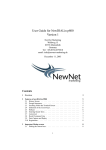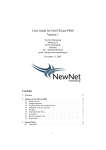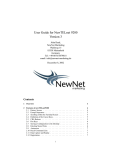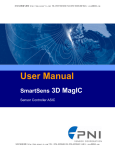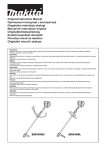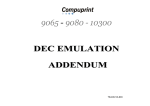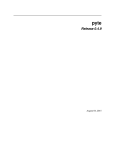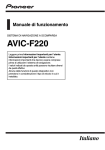Download User Guide for NewTEL95 Version 1 - NewNet
Transcript
User Guide for NewTEL95 Version 1 NewNet Marketing Waldweg 15 83558 Maitenbeth Germany Tel: +49-8076-8879818 email: [email protected] July 21, 2005 Contents 1 Overview 3 2 Features of NewTEL95 2.1 Start Screen . . . . . . . . . . . . . 2.2 History Screen . . . . . . . . . . . 2.3 Escape Sequences . . . . . . . . . . 2.4 Scrolling within the Terminal Screen 2.5 Denition of the Cursor Keys . . . . 2.6 Hot Keys . . . . . . . . . . . . . . 2.7 Entering Stored Texts . . . . . . . . 2.8 Autocursor . . . . . . . . . . . . . 2.9 Recall Command Line . . . . . . . 2.10 Registration . . . . . . . . . . . . . . . . . . . . . . . 5 5 5 6 6 6 6 6 7 7 7 3 Special Modes 3.1 Ping Mode . . . . . . . . . . . . . . . . . . . . . . . . . . . . . . . . 3.2 Path Mode . . . . . . . . . . . . . . . . . . . . . . . . . . . . . . . . 9 9 10 1 . . . . . . . . . . . . . . . . . . . . . . . . . . . . . . . . . . . . . . . . . . . . . . . . . . . . . . . . . . . . . . . . . . . . . . . . . . . . . . . . . . . . . . . . . . . . . . . . . . . . . . . . . . . . . . . . . . . . . . . . . . . . . . . . . . . . . . . . . . . . . . . . . . . . . . . . . . . . . . . . . . . . . . . . . . 4 Important Dialog Screens 4.1 Connecting to the remote host . . . . . . . . . . . . . . . . . . . . . 4.2 Buttons Dialog . . . . . . . . . . . . . . . . . . . . . . . . . . . . . 4.3 Stored Texts Dialog . . . . . . . . . . . . . . . . . . . . . . . . . . . 12 12 12 12 5 Specication 14 List of Figures 1 2 3 4 5 6 7 8 9 10 Connected to a remote system . . Main window at start . . . . . . . Ping Connection Dialog . . . . . . Results of a Ping . . . . . . . . . Path Connection Dialog . . . . . . Results of a path analysis . . . . . Setting the parameters for the path Remote connection dialog . . . . Buttons Dialog . . . . . . . . . . Stored Texts Dialog . . . . . . . . . . . . . . . . . . . . . . . . . . . . . . . . . . . . . . . . . . . . . . . . . . . . . . . . . . . . . . . . . . . . . . . . . . . . . . . . . . . . . . . . . . . . . . . . . . . . . . . . . . . . . . . . . . . . . . . . . . . . . . . . . . . . . . . . . . . . . . . . . . . . . . . . . . . . . . . . . . . . . . . . . . . . . . . . . . . . . . . . . . . . . . . . . . . . . . 3 5 9 9 10 11 11 12 13 13 Special Keys for control character entry . . . . ANSI codes sent from keyboard . . . . . . . . Character translation in Special Graphics Mode ANSI and VT100 supported escape sequences . . . . . . . . . . . . . . . . . . . . . . . . . . . . . . . . . . . . . . . . . . . . . . . . . 7 14 15 16 List of Tables 1 2 3 4 2 1 Overview NewTEL95, the TELNET terminal emulator, is the ideal tool for the system manager to access his system remotely and work interactively via the command line. He does not need to be near his ofce, or even have a power plug near him. He just uses the TELNET connection via the TCP/IP stack in the Nokia Communication 9300/9500. NewTEL95 has been fully tested with all the standard LINUX utilities, and supports all major escape sequences. The NewTEL95 application from NewNet Marketing for the Nokia Communication 9300/9500 gives remote access to a system via Internet connected over the mobile telephone. NewTEL95 is compliant to all the important ANSI, VT100, VT2xx, VT52, TVI950, WYSE60, and ADM3A escape sequences and is therefore ideal to access a remote LINUX, or any other UNIX system. Figure 2 shows the NewTEL95 main screen immediately after it is started. The program version and registration status are shown at the top. This page lists previous connections with the remote host address, and an optional name. The entry can then be called directly by selecting it, and pressing the Call CBA button. This list is, of course, empty the rst time that NewTEL95 is started. A TELNET call can be made to other destinations by pressing the button (TELNET ), the ping or path mode selected with either the ping or path CBA buttons. NewTEL95 has been fully tested against most escape sequence heavy applications, eg. Top - the system display, Joe - the editor, Pine - the e-mail client. In gure 1 you can see a running session connected to a remote LINUX system. The screen on the Nokia Communication 9300/9500 is smaller than the complete terminal screen, and this will mean that the user must scroll to be able read all the screen content. To scroll within the terminal screen, the shift key should be pressed together with one of the direction keys. This can be also be done automatically by using the follow mode. Figure 1: Connected to a remote system Control characters, e.g Ctrl-C, can be entered directly in NewTEL95 via the Special Chars. In addition to this, hotkeys can be dened for easy access of standard texts. These hotkeys are preloaded with the F1..F10, but the contents can be changed by the user. To ease the entry of standard text blocks, these can be stored in buffers within NewTEL95 for direct entry, and selected onto one of the buttons menu entries. Commands or stored texts can be placed on the buttons menu. 3 The last command that was entered from the keyboard can be easily recalled by pressing the recall button, this function is normally called being linked to a button menu entry. NewTEL95 can be downloaded for test, it includes both English and German texts. The download version is fully functional but has an additional information screen displayed when going online. This screen disappears after the registration code has been entered. The registration is done easily via one of the online registration companies listed on our web site http://www.newnet-marketing.de or directly there online. 4 2 Features of NewTEL95 2.1 Start Screen The NewTEL95 start screen lists the previous TELNET, ping, and path connections so that the user can reconnect very quickly and simply. Each entry has an additional eld so that a meaningful name can be given to easily identify the network address. Figure 2: Main window at start 2.2 History Screen A history screen can be selected to display the data collected since the program was started. The history is limited to a maximum size, which can be set by the user. The history collection can be enabled, or disabled per default via the History menu found under Capture. The default mode records all data received, and attempts to format the text in an approximation to the original data. This is, however, not possible when the data was formatted by direct cursor addressing. When full mode is selected, then all data sent and received will be recorded. The data will be expanded so that all binary data can be analyzed. This mode is normally only used for debugging purposes. To display the data in the history select the display history menu, or press the history button entry. A new screen will appear covering the terminal window showing the text stored in the history buffer. It will be noted that escape sequences are not processed on this screen as it is not a terminal emulation. They are, however, removed from the text, when collecting in default mode. If you wish to copy the data into the clipboard for use within other applications, you can either select sections of the text by pressing up-arrow and the direction key, or you select all the text by using the edit menu The selected text can be copied into the clipboard by pressing the copy entry on the edit menu. To return to the default operation this screen must be removed. To do this just press the toolbar button close. The buffer contents are not removed, and will continue to ll unless cleared, or turned off. The history buffer will ll to the maximum level, and will then stay at this size. To clear the history buffer, press the clear button. The screen will then be cleared, and the data will be at the start of a new buffer 5 2.3 Escape Sequences NewTEL95 supports the ANSI standard escape sequences including the colour formatting statements. • In ANSI mode, NewTEL95 will also process any DEC VT200 control sequences. This mode is shown as ANSI/VT2xx. • VT100 , VT52 , TVI950 , WYSE60 , and ADM3A are not compatible to each other, and must be selected via the menu. 2.4 Scrolling within the Terminal Screen The PDA screen is smaller than the corresponding terminal screen. This will probably mean that you can only display a part of the emulated terminal on the NewTEL95 screen, depending on the selected font size. To scroll within the terminal screen, the shift key should be pressed together with one of the direction keys. When the follow mode is selected, either from the menu or a button, then the screen will always scroll to display the cursor. This can, depending on the the remote application, ease user entry considerably, and is described in section 2.8. 2.5 Denition of the Cursor Keys The cursor key escape sequences for the various terminal types, stored in NewTEL95, normally work with most remote products. However, sometimes they have to be modied for special needs. They can be directly edited in the dialog. All control characters can be entered by using the entry methods as shown in Figure 1. 2.6 Hot Keys The hot keys entry on the buttons menu has hot 1..hot 10 positions which will automatically send a stored string when clicked. The default values are the ANSI F1..F10 escape sequences. The strings can, however, be changed to store any other values. A typical use for one of these hotkeys is to store the UNIX pipe character, which cannot be entered directly from the keyboard. Note The UNIX pipe command can be easily stored and sent from a hotkey. An example of storing the pipe command in hotkey 1: Using Menu-Buttons - Stored Codes (as described in section 2.7, change text in eld Hot1 to \x7C. The pipe character can now be sent by the clicking hot 1 menu entry (Buttons - hot keys - hot 1). 2.7 Entering Stored Texts To ease the entry of standard texts, these can be stored in NewTEL95 buffers, and then linked to the menu buttons. There are 8 buffers in total. The text will be sent to the host when the button is clicked. The menu allows entry of special keys, eg. escape, carriage return, etc. by using the standard C-syntax. Figure 1 lists the special keys, and their meaning. 6 description Escape character Carriage return New line Tabstop Backslash Any character entry \e \r \n \t \\ \xnn where the nn is the hexadecimal value of this character. Table 1: Special Keys for control character entry Note: If the stored text is to be used as a command for the system, it will probably need to be terminated with carriage return \; 2.8 Autocursor The cursor follow function will automatically scroll the window so that the cursor is in the visible section. This can be selected via the menu, or a button. Depending on the host software, this can either be an advantage, or cause irritation. Some software always moves the cursor to the bottom of the screen, even though the important data is at the top, in this case the autocursor function should be disabled. 2.9 Recall Command Line Most commands entered for the remote system are terminated by a carriage return key(CR). The recall function within NewTEL95 automatically stores strings sent in this way, and allows them to be resent by simply pressing the Recall button. This function is only available as a buttons menu entry, so it must be selected via the Buttons menu before being used. When the command line is recalled via the Recall button, the CR is not sent. This allows the user to edit, or cancel the line before it is performed by the remote system. 2.10 Registration newTEL95 can be tested without charge by downloading it from http: www.newnet-marketing.de. This allow users to fully test it before deciding whether it is useful to them. When the user decides to register, then this must be done via NewNet Marketing (http://www.newnet-marketing.de), or one the registration partners. A complete list of partners is available on the NewNet Marketing web-site. For a standard single-user license, the Communicator IMEI number, and the user name entered for the registration must be entered. The NewTEL95 is then registered to run. The IMEI number identies the Nokia Communication 9300/9500, and the user name will then appear on the starter page of NewTEL95. The Nokia Communication 9300/9500 IMEI number can be easily got by entering the following characters on the telephone keypad: *#06#. The IMEI number then appears on the display. NewTEL95 will also display the IMEI in the About window. NewNet Marketing will then send the user a NewTEL95 registration code and user name via e-mail which is specically valid for this Nokia Communication 9300/9500. 7 Should the IMEI code change after registration, perhaps due to a phone repair, then just send an email to [email protected] with the new IMEI number. The user name and registration code should be entered in the registration dialog found in the Tools menu. The main page should now display the user name instead of the unregistered version text. It is not necessary to reinstall, or update NewTEL95 for this registration, however, it is wise to use the latest version, which can always be found at the NewNet Marketing web-site (http:://www.newnet-marketing.de). NewNet Marketing has a policy of free upgrades for their products. This means that any upgrades for NewTEL95 that become available can be installed without having to re-register the application. When additional features become available within the product that were not available at the time of registration, it is, however, possible that an update registration might be requested before using these new features. 8 3 Special Modes 3.1 Ping Mode The Ping mode is a completely independent mode selected from the path/ping toolbar button. When in this mode, all operations refer to Pinging a remote host. From this mode you can enter Path mode directly to detect the path taken by a connection to a remote host. The standard mode must be reentered before the TELNET terminal connectivity functions can be used by pressing the Finish button. Tip: Before attempting to start a PING to a remote host for the rst time, check that the Internet Access Point is correctly set up by accessing the internet using the phone's www-browser. Figure 3: Ping Connection Dialog The PING is started by pressing the toolbar button Start. A dialog will then allow a remote host name, or address as shown in g 3. The connection to the ISP will then be started and ICMP packets sent and their turn around time measured. For each packet that returns from the host the delay is calculated. The data is also checked for corruption and will be agged should this occur. After the specied number of packets has been sent, it will stop and will then print all the results on the screen as seen in Fig. 4. It is then back in the STOP status, and a new remote host could be selected. There are several menu commands that can be Figure 4: Results of a Ping selected in this mode, including the Capture functions, an select all to copy the 9 screen contents into the clipboard so that they can be pasted into another applications e.g. email. The parameters for the PING can be set with the Parameters menu selection. This includes the length of data that should be sent, the number of ICMP packets that should be sent to the remote host before automatically stopping, and the time interval in milliseconds between each packet that is sent out. 3.2 Path Mode The Path mode is a completely independent mode selected from the path/ping toolbar button. This mode is normally entered from the Ping mode by selecting the CBA button Path. From this mode you can enter Ping mode to check the connectivity to a specic host in the internet. The standard mode must be reentered before the TELNET terminal connectivity functions can be used by pressing the Finish button. Tip: Before attempting to start a PATH to a remote host for the rst time, check that the Internet Access Point is correctly set up by accessing the internet using the phone's www-browser. The PATH is started by pressing the toolbar button Start. A dialog will then allow a remote host name, or address as can be seen in g. 5. The PATH will then start the Figure 5: Path Connection Dialog connection, and will print all hosts that it nds on the way to the remote host as results on the screen. It will rst step through the network and the screen will slowly ll with the names, or if there is no name for the host, then only the address. When it has found all the hosts in the path to the remote host, then it will start pingingthem to see what response time is possible from each. The maximum, minimum and average are show. Colors show if any hosts differ greatly from the average delay. After completing the PATH, it will complete and return to the STOP status and the screen will display the data as shown in g 6. There are several menu commands that can be selected in this mode, including the Capture functions, an select all to copy the screen contents into the clipboard so that they can be pasted into another applications e.g. email. The parameters for the PATH can be set with the Parameters menu selection as shown in g. 7. 10 Figure 6: Results of a path analysis Figure 7: Setting the parameters for the path 11 4 Important Dialog Screens 4.1 Connecting to the remote host The new TELNET connection is selected by pressing the (Telnet) toolbar button as can be seen in gure 8 from the main screen. If the address is selected via the main page, then the connection dialog is not displayed. Figure 8: Remote connection dialog Tip: Before attempting to start a TELNET connection for the rst time, check that the Internet Access Point is correctly setup by accessing the internet using the Nokia Communication 9300/9500 www-browser. The multi-page dialog is shown in gure 8. The connection is started by clicking the ok button. A The rst page of this dialog shows the current remote host name or address, and allows the name, or address to be edited. The remote port can also be entered in this dialog. This has a default value of 23, and does not normally need to be changed. All hosts selected by this means are entered into the list on the main page, and will also appear in the history page of this dialog. Previous entries can be selected directly from the second page of the dialog. 4.2 Buttons Dialog This dialog will be found by selecting the Edit - Preferences - buttons menu. Figure 9 shows the dialog which should be called to dene the function or text performed when one of the CBA buttons displayed on the main screen are selected. There are 2 groups of 4 buttons, to switch between the groups press the alt-key. For each button, there is a roll-down list to allow the user to select either a stored text (1 - 8), or a command to be placed on this button. When the command or text has been selected, the title of the stored text or the command name will afterwards appear in the buttons menu on the screen to make selection easier. 4.3 Stored Texts Dialog Figure 10 shows the dialog which allows the texts that sent to the remote system when the hot-key or button menu entry is clicked to be entered. They are set in the Stored 12 Figure 9: Buttons Dialog Figure 10: Stored Texts Dialog Texts dialog, shown in Figure 10. There are 10 hot-key buffers available in NewTEL95, these are preloaded with the escape sequences for F1 .. F10. They can, however, be reloaded with any other text up to a maximum length of 254 chars. Note The F1..F10 control sequences are not standardized, and might have to be set to a different value to communicate with your system. The hot-key texts are sent when the hot-key menu entries are pressed, as described later in section 2.6. The 8 Stored Texts can also be inserted, and edited using this dialog. A title is allotted to each text. This title will appear in the buttons menu, when it is selected, using the Buttons Dialog, described in Section 4.2. Control characters can be entered into both the hot-key and the stored text buffers in a simple C-like syntax. This is described in section 2.6. 13 Key Cursor Left Cursor Right Cursor Up Cursor Down Page Down Page Up Home End F1 F2 F3 F4 F5 F6 F7 F8 F9 F10 Table 2: ANSI codes sent from keyboard Control Function Comments CSI D CSI C CSI A CSI B CSI 6 CSI 5 CSI 1 CSI 4 CSI OP Can be modied at any time CSI OQ Can be modied at any time CSI OR Can be modied at any time CSI OS Can be modied at any time CSI [6 Can be modied at any time CSI [17 Can be modied at any time CSI [18 Can be modied at any time CSI [19 Can be modied at any time CSI [20 Can be modied at any time CSI [21 Can be modied at any time 5 Specication Screen: max. 132 x 44, min 40 x 10, default: 80 x 24, ANSI colour functions Escape sequences: ANSI, VT2xx, VT100, VT52, TVI950, WYSE60, ADM3A Hotkeys: default settings for F1 .. F10. Stored texts: 8 buffers with their titles, 254 chars. max. length of text including control characters. Charset: All character sets installed in the country version of the Nokia Communication 9300/9500. Recall: last entered command will be resent to the remote system. History: The default mode stores all received data, which can easily be seen by displaying the history screen. The History can also store all the data sent, and received in Full mode to assist in fault nding. 14 Table 3: Character translation in Special Graphics Mode Input char Output Comments 0x71 0x97 Horizontal line 0x78 0x7C Vertical bar 0X7D 0XA3 Pound sign 0X6A, 0X6E, 0X2B Corners (top left, top right, bottom left, bottom right). 0X74, 0X77 These are completely replaced by a plus sign as there are no graphic symbols available in the fonts. 15 Table 4: ANSI and VT100 supported escape sequences Escape code CSI Ps ; Ps m CSI Pt ; Pb r Name SGR Select Graphic Rendition DECSTBM Set Top and Bottom Margins CSI Pn A CUU - Cursor Up CSI Pn B CUD Cursor Down CSI Pn C CUF Cursor Forward CSI Pn D CUB Cursor Backward CSI Pn E CSI Pn F CNL Cursor Next Line CPL Cursor Previous Line CSI Pn G CHA Cursor Horizontal Absolute CUP Cursor Position CSI Pl ; Pc H CSI Pn I CSI Ps J CHT Cursor Horizontal Tabulation ED Erase in Display 16 Description This control sets one or more character attributes at the same time. This control function sets the top and bottom margins for the current page. You cannot perform scrolling outside the margins. Moves the cursor up a specied number of lines in the same column. The cursor stops at the top margin. If the cursor is already above the top margin, then the cursor stops at the top line. This control function moves the cursor down a specied number of lines in the same column. The cursor stops at the bottom margin. This control function moves the cursor to right by a specied number of columns. The cursor stops at the right border of the page. This control function moves the cursor to the left by a specied number of columns. The cursor stops at the left border of the page. Move the cursor to the next line. Move the cursor to the preceding line. Move the active position to the n-th character of the active line. This control function moves the cursor to the specied line and column. Move the active position Forward n tabs forward This control function erases characters from part or all of the display. Ps = 0, From Cursor through the end of display; Ps=1, From beginning of the display through the cursor; Ps=2, The complete display. CSI Ps K EL Erase in Line CSI Pn L IL Insert Line CSI Pn M DL Delete Line CSI Pn d CSI Pn T VPA Vertical Line Position Absolute SD Pan Up CSI Pn S SU Pan Down CSI Pn @ ICH Insert Character CSI Pn P DCH Delete Character ESC 6 DECBI Back Index ESC 9 DECFI Forward Index ESC D IND - Index ESC M RI Reverse Index ESC E NEL Next Line CSI u SCORC Restore Saved Cursor Position SCOSC Save Current Cursor Position DECKPAR DEC SCSG0 DEC SCSG1 DEC SCSG2 CSI s ESC = ESC ( ESC ) ESC * 17 This control function erases characters on the line that has the cursor. Ps=0, From the cursor to the end of the line; Ps=1, From the beginning of the line through the cursor; Ps=2, The complete line. This control function inserts one or more blank lines, starting at the cursor. This control function deletes one or more lines in the scrolling region, starting with the line that has the cursor. Move to the corresponding vertical position of the current column. This control function moves the user window up a specied number of lines in page memory. This control function moves the user window down a specied number of lines in page memory. This control function inserts one or more space (SP) characters starting at the cursor position. This control function deletes one or more characters from the cursor position to the right. This control function moves the cursor backwards one column. This control function moves the cursor forwards one column. IND moves the cursor down one line in the same column. RI moves the cursor up one line in the same column. Moves cursor to rst position on next line. Moves cursor to the position saved by save cursor command. Save current cursor position. Null Select Graphic mode 0 Select Graphic mode 1 Select Graphic mode 2 ESC + ESC Z CSI c DEC SCSG3 DEC ID- Identify device DA1 Primary Device attributes Select Graphic mode 3 Reply with identication string Reply with Attributes 1. CSI is the control sequence introducer. For the 7-bit sequences used by newTEL95, this is replaced by ESC followed by [ 2. Ps, Pt, etc. are integer parameters. 18 Index Ping Mode, 9 Ping Results, 9 ADM3A mode, 6 ANSI mode, 6 Auto cursor, 7 Recall button, 4, 7 Registration code, 8 Remote connection dialog, 12 Buttons dialog, 13 Copy history data, 5 Cursor Down Key, 14 Cursor keys, 6 Cursor Left Key, 14 Cursor Right Key, 14 Cursor Up Key, 14 Scrolling, 3, 6 Special Keys, 7 Stored texts, 6 Stored texts dialog, 13 TVI950 mode, 6 End Key, 14 Escape sequences, 6 Unix Pipe command, 6 VT100 mode, 6 VT52 mode, 6 F1 Code, 14 F10 Code, 14 F2 Code, 14 F3 Code, 14 F4 Code, 14 F5 Code, 14 F6 Code, 14 F7 Code, 14 F8 Code, 14 Follow Mode, 6 WYSE60 mode, 6 History clear button, 5 History Close, 5 History default mode, 5 History display, 5 History full mode, 5 History maximum size, 5 History Screen, 5 Home Key, 14 Hot Keys, 6 IMEI number, 7 Main window, 5 Page Down Key, 14 Page Up Key, 14 Path Connection Dialog, 10 Path Mode, 10 Path Parameters, 11 Path Results, 11 Ping Connection Dialog, 9 19



















